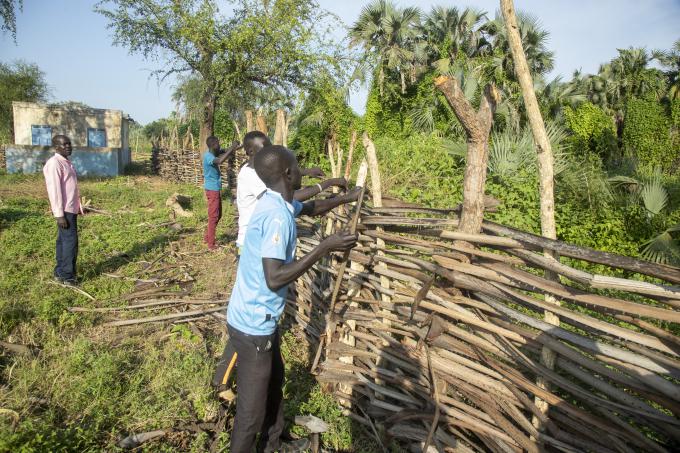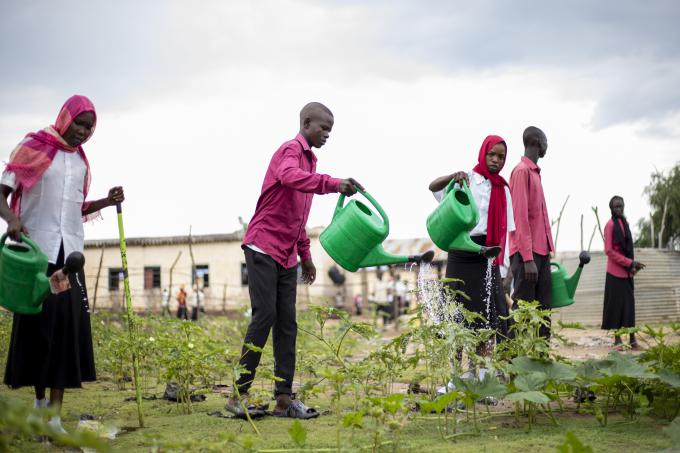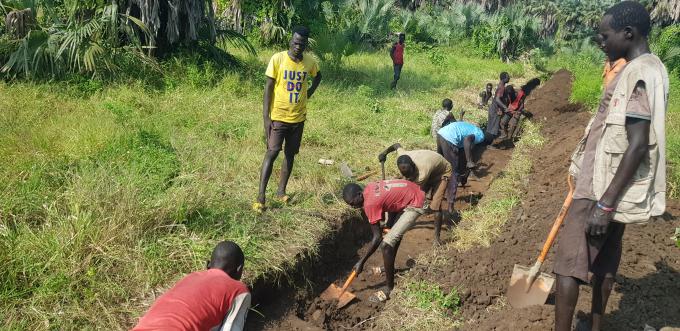From School Gardens to Trenches: How Save the Children Anticipatory Action Project Responds to Flash Floods in Maban.
Maban, South Sudan – In South Sudan, floods are a chronic and acute problem during rainy season. Historically, flooding in Maban happens every year at different intensities, often submerging villages and destroying shelters, WASH facilities, education activities, roads, and airstrips. The floods in Maban are caused mainly by heavy rains from the neighboring Ethiopian highlands. On average, two days after it rains in Ethiopian highlands, the floods into Maban.

Dikes dug by students to protect their school from flash floods in Maban. Photo: Bebe Joel/Save the Children
Save the Children has been working to mitigate the impact of floods on education in Maban, which has been hit hard by these natural disasters. As floods become increasingly common, many families have been forced to seek shelter in schools, disrupting learning. In response, Save the Children provided funding to ten schools in Maban under the Anticipatory Action Project funded by Danish International Development Agency (Danida). The project aimed to strengthen children's skills in reducing the risks and impacts of potential disasters in their communities, by forming Disaster Risks Reduction (DRR) clubs led by children.
Atar*, 16, a primary in Maban, explained how they used the funding from Danida through Save the Children to construct a fence around the school, preventing the community from using classrooms as shelters that interrupted learning.
"We built a fence around the school to prevent the community from using classrooms as shelters and interrupting learning.", said Atar.

Students in Maban fencing their school. Photo: Bebe Joel/Save the Children
Maban gets food supply from Sudan or some parts of South Sudan like Juba and Wau. Because of the flooding, traders lost access to bring food to Maban. Bazika*, 17 another student, said that they used the funding provided by Save the Children to create a school garden where they grew crops that could be consumed locally during flooding.

Students in Maban watering their vegetables planted within the school compound. Photo: Bebe Joel/Save the Children
"The floods sometimes last for several days. It is very important to have a lot of food stored in storage. That is why as DRR club we decided to introduce school gardening where we grow crops which can be consumed locally when there is flooding and there is no access for roads for traders to bring food.”, said – Bazika.
Similarly, in Maban, the disaster risk club used the funds to construct a fence to protect students from the river located behind the school.
“I am happy that Save the Children and Danida supported us. Now our school is fenced which has really improved our studies and students cannot skip classes to go and play in the river. The fence also helped in blocking cows from grazing near classrooms because some of them made a lot of noise while we were studying”, said Peter, 52, a teacher from Maban.
Some schools used the funding to secure their school from flooding by digging trenches to block floodwater and repairing all the damaged windows in the classrooms.

DDR club members dig dikes to prevent flash floods in Maban. Photo: Bebe Joel/Save the Children
“Using funding given by Danida through Save the Childrenour school is now secure from water of flooding because we constructed trenches. We also fixed windows which were used by people who were displaced by flooding to enter the classrooms. Now we can study without disturbance.” – Sarah*, 13, one of the students.
Save the Children involved the voices of children to participate in activities that benefit their communities, and they have also created opportunities for children to conduct peer education and awareness on early warning signs for existing disasters and protecting each other in times of disaster occurrence. With these educational and practical support programs, Save the Children hopes that children in Maban will be better prepared to mitigate the risks of natural disasters and live in greater security and safety in the years ahead.
"Overall, the support provided by Save the Children and Danida has enabled children to continue their education during floods and has contributed to building resilience in communities to reduce the impact of disasters”, said Ojara Gorge, Save the Children acting program manager.
In addition to the floods, the situation of children and youth in Maban is affected by risk of violence, abuse, exploitation, and other grave rights violations. The most significant protection threats to refugee children in Maban continue to be separation from family, recruitment into armed groups, sexual exploitation and early marriage, physical harm, and psychosocial distress.
Edited by Tito Justin/Save the Children
 South Sudan
South Sudan